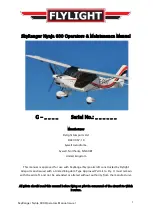
27
EXTREME FLYING MANOEUVRES
Wingover:
To induce a wingover the pilot flies consecutive alternating turns to gradually steepen
the angle of bank. During wingovers with a high bank angle, the outside wing begins to
unload. Continually increasing the angle of bank must be avoided to avoid dynamic
collapses.
WARNING!
Full-stall, spin and wingovers (over 90 degree angle of bank) are prohibited
aerobatic manoeuvres and may not be performed during normal flying. Incorrect
recovery procedures or overreaction of the pilot may have dangerous consequences!
Attention!
The Chronos is not designed to be used for aerobatics.
Alternative (emergency) steering:
If for some reason it becomes impossible to control the Chronos with the brake lines,
the D-risers may be used to steer and land the canopy safely.
Attention:
When using the D-risers the brake range is much shorter (10-15 cm) then
with the brakes. It is also possible to control the direction of the flight by pulling on a
stabilizer line or by weight-shifting.
RAPID DESCENT TECHNIQUES
Spiral dive:
Attention! Set trim setting in slow or neutral and turn your paramotor off when
executing spiral dive.
A spiral dive is the fastest way to lose altitude; however, the very high G-forces make it
difficult to sustain a spiral dive for long. It also places high loads on the pilot and glider.
By tensing ones abdominal muscles and a higher body tension you can to some extent
resist the high G-forces. Don't forget proper breathing to keep the blood flowing to avoid
blacking out. As soon as you feel any slight dizziness or impaired vision the spiral
should be exited immediately.
The Chronos has a very effective spiral dive. This allows rapid descent without stalling.
To enter a spiral dive the pilot should weight-shift to one side while slowly pulling the
brake gradually on the same side. During a spiral dive the angle of bank can be
controlled by increasing or reducing the amount of inside brake. When spiral diving the
Chronos, it is recommended that the outside brake be lightly applied. This helps
stabilize the wing and enables an easier and safer exit from the spiral. To exit, release
the inside brake slowly. At higher sink speeds or if the pilot keeps his weight on the
inside, the wing can stay in a continued deep spiral and has to be actively exited. This is
done by weight shifting to the outside and gently applying brake to the opposite side.
Summary of Contents for Chronos
Page 1: ...1 ...
Page 10: ...10 TRIMMING ...
Page 35: ...35 LINE PLAN CHRONOS SCHEME ...
Page 40: ...40 ...








































